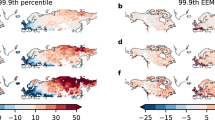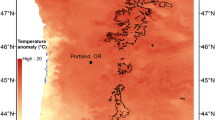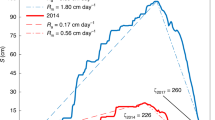Abstract
Snowfall is an important element of the climate system, and one that is expected to change in a warming climate1,2,3,4. Both mean snowfall and the intensity distribution of snowfall are important, with heavy snowfall events having particularly large economic and human impacts5,6,7. Simulations with climate models indicate that annual mean snowfall declines with warming in most regions but increases in regions with very low surface temperatures3,4. The response of heavy snowfall events to a changing climate, however, is unclear. Here I show that in simulations with climate models under a scenario of high emissions of greenhouse gases, by the late twenty-first century there are smaller fractional changes in the intensities of daily snowfall extremes than in mean snowfall over many Northern Hemisphere land regions. For example, for monthly climatological temperatures just below freezing and surface elevations below 1,000 metres, the 99.99th percentile of daily snowfall decreases by 8% in the multimodel median, compared to a 65% reduction in mean snowfall. Both mean and extreme snowfall must decrease for a sufficiently large warming, but the climatological temperature above which snowfall extremes decrease with warming in the simulations is as high as −9 °C, compared to −14 °C for mean snowfall. These results are supported by a physically based theory that is consistent with the observed rain–snow transition. According to the theory, snowfall extremes occur near an optimal temperature that is insensitive to climate warming, and this results in smaller fractional changes for higher percentiles of daily snowfall. The simulated changes in snowfall that I find would influence surface snow and its hazards; these changes also suggest that it may be difficult to detect a regional climate-change signal in snowfall extremes.
This is a preview of subscription content, access via your institution
Access options
Subscribe to this journal
Receive 51 print issues and online access
$199.00 per year
only $3.90 per issue
Buy this article
- Purchase on Springer Link
- Instant access to full article PDF
Prices may be subject to local taxes which are calculated during checkout




Similar content being viewed by others
References
Räisänen, J. Warmer climate: less or more snow? Clim. Dyn. 30, 307–319 (2008)
Brown, R. D. & Mote, P. W. The response of northern hemisphere snow cover to a changing climate. J. Clim. 22, 2124–2145 (2009)
Kapnick, S. B. & Delworth, T. L. Controls of global snow under a changed climate. J. Clim. 26, 5537–5562 (2013)
Krasting, J. P., Broccoli, A. J., Dixon, K. & Lanzante, J. Future changes in northern hemisphere snowfall. J. Clim. 26, 7813–7828 (2013)
Rooney, J. F., Jr The urban snow hazard in the United States: an appraisal of disruption. Geogr. Rev. 57, 538–559 (1967)
Kocin, P. J. & Uccellini, L. W. Northeast Snowstorms Ch. 1 (American Meteorological Society, 2004)
Changnon, S. A. & Changnon, D. A spatial and temporal analysis of damaging snowstorms in the United States. Nat. Hazards 37, 373–389 (2006)
Min, S. K., Zhang, X., Zwiers, F. W. & Hegerl, G. C. Human contribution to more-intense precipitation extremes. Nature 470, 378–381 (2011)
Westra, S., Alexander, L. V. & Zwiers, F. W. Global increasing trends in annual maximum daily precipitation. J. Clim. 26, 3904–3918 (2013)
Kharin, V. V., Zwiers, F. W., Zhang, X. & Wehner, M. Changes in temperature and precipitation extremes in the CMIP5 ensemble. Clim. Change 119, 345–357 (2013)
Trenberth, K. E. Conceptual framework for changes of extremes of the hydrological cycle with climate change. Clim. Change 42, 327–339 (1999)
O’Gorman, P. A. & Schneider, T. The physical basis for increases in precipitation extremes in simulations of 21st-century climate change. Proc. Natl Acad. Sci. USA 106, 14773–14777 (2009)
O’Gorman, P. A. & Schneider, T. Scaling of precipitation extremes over a wide range of climates simulated with an idealized GCM. J. Clim. 22, 5676–5685 (2009)
Kunkel, K. E. et al. Monitoring and understanding trends in extreme storms: state of knowledge. Bull. Am. Meteorol. Soc. 94, 499–514 (2013)
Zhang, X., Hogg, W. D. & Mekis, É. Spatial and temporal characteristics of heavy precipitation events over Canada. J. Clim. 14, 1923–1936 (2001)
Kunkel, K. E. et al. Trends in twentieth-century U.S. extreme snowfall seasons. J. Clim. 22, 6204–6216 (2009)
Diffenbaugh, N. S., Scherer, M. & Ashfaq, M. Response of snow-dependent hydrologic extremes to continued global warming. Nature Clim. Change 3, 379–384 (2013)
Changnon, S. A., Changnon, D. & Karl, T. R. Temporal and spatial characteristics of snowstorms in the contiguous United States. J. Appl. Meteorol. Climatol. 45, 1141–1155 (2006)
Kodra, E., Steinhaeuser, K. & Ganguly, A. R. Persisting cold extremes under 21st-century warming scenarios. Geophys. Res. Lett. 38, L08705 (2011)
Bourgouin, P. A method to determine precipitation types. Weath. Forecast. 15, 583–592 (2000)
Dai, A. Temperature and pressure dependence of the rain-snow phase transition over land and ocean. Geophys. Res. Lett. 35, L12802 (2008)
Feiccabrino, J., Gustafsson, D. & Lundberg, A. Surface-based precipitation phase determination methods in hydrological models. Hydrol. Res. 44, 44–57 (2013)
Siler, N. & Roe, G. How will orographic precipitation respond to surface warming? An idealized thermodynamic perspective. Geophys. Res. Lett. 41, 2606–2613 (2014)
Pierce, D. W. & Cayan, D. R. The uneven response of different snow measures to human-induced climate warming. J. Clim. 26, 4148–4167 (2013)
Hosking, J. R. M., Wallis, J. R. & Wood, E. F. Estimation of the generalized extreme-value distribution by the method of probability-weighted moments. Technometrics 27, 251–261 (1985)
Kharin, V. V. & Zwiers, F. W. Changes in the extremes in an ensemble of transient climate simulations with a coupled atmosphere-ocean GCM. J. Clim. 13, 3760–3788 (2000)
Huffman, G. J. et al. Global precipitation at one-degree daily resolution from multisatellite observations. J. Hydrometeorol. 2, 36–50 (2001)
Chen, C. T. & Knutson, T. On the verification and comparison of extreme rainfall indices from climate models. J. Clim. 21, 1605–1621 (2008)
Kanamitsu, M. et al. NCEP–DOE AMIP-II reanalysis (R-2). Bull. Am. Meteorol. Soc. 83, 1631–1643 (2002)
Stephens, G. L. et al. CloudSat mission: performance and early science after the first year of operation. J. Geophys. Res. 113, D00A18 (2008)
Wood, N. Level 2c snow profile process description and interface control document, version 0. http://www.cloudsat.cira.colostate.edu/dataICDlist.php?go=list&path=/2C-SNOW-PROFILE (2013)
Lenderink, G. & van Meijgaard, E. Increase in hourly precipitation extremes beyond expectations from temperature changes. Nature Geosci. 1, 511–514 (2008)
Groisman, P. Y. et al. Changes in the probability of heavy precipitation: Important indicators of climatic change. Clim. Change 42, 243–283 (1999)
Abramowitz, M. & Stegun, I. A. Handbook of Mathematical Functions: With Formulas, Graphs, and Mathematical Tables Vol. 55, section 6.5.32 (Dover, 1964)
Bender, C. M. & Orszag, S. A. Advanced Mathematical Methods for Scientists and Engineers I: Asymptotic Methods and Perturbation Theory Vol. 1, Ch. 6 (Springer, 1999)
Furrer, E. M. & Katz, R. W. Improving the simulation of extreme precipitation events by stochastic weather generators. Water Resourc. Res. 44, W12439 (2008)
de Vries, H., Haarsma, R. J. & Hazeleger, W. On the future reduction of snowfall in western and central Europe. Clim. Dyn. 41, 2319–2330 (2013)
Wilcox, E. M. & Donner, L. J. The frequency of extreme rain events in satellite rain-rate estimates and an atmospheric general circulation model. J. Clim. 20, 53–69 (2007)
O’Gorman, P. A. Sensitivity of tropical precipitation extremes to climate change. Nature Geosci. 5, 697–700 (2012)
Massonnet, F. et al. Constraining projections of summer Arctic sea ice. Cryosphere 6, 1383–1394 (2012)
Paulhus, J. L. H. Record snowfall of April 14–15, 1921, at Silver Lake, Colorado. Mon. Weath. Rev. 81, 38–40 (1953)
Brown, R. D., Brasnett, B. & Robinson, D. Gridded North American monthly snow depth and snow water equivalent for GCM evaluation. Atmosphere–Ocean 41, 1–14 (2003)
Acknowledgements
I thank M. Singh, S. Pfahl, J. Feiccabrino and I. Held for discussions. I am grateful to N. Wood, G. Stephens and the NASA CloudSat project for providing CloudSat snowfall data. I acknowledge the World Climate Research Programme’s Working Group on Coupled Modelling, which is responsible for CMIP, and I thank the climate modelling groups for producing and making available their model output. For CMIP the US Department of Energy’s Program for Climate Model Diagnosis and Intercomparison provides coordinating support and led development of software infrastructure in partnership with the Global Organization for Earth System Science Portals. GPCP 1-degree daily precipitation data were downloaded from http://www1.ncdc.noaa.gov/pub/data/gpcp/1dd-v1.2/. NCEP-DOE Reanalysis 2 data were provided by the NOAA/OAR/ESRL PSD at http://www.esrl.noaa.gov/psd. I acknowledge support from NSF grant number AGS-1148594 and NASA ROSES grant number 09-IDS09-0049.
Author information
Authors and Affiliations
Corresponding author
Ethics declarations
Competing interests
The author declares no competing financial interests.
Extended data figures and tables
Extended Data Figure 1 Mean snowfall in simulations and observations.
a, The control climate in the multimodel median. b, c, Observational estimates from GPCP/NCEP2 (b) and CloudSat (c). In each case, results are only shown where mean snowfall exceeds 5 cm per year.
Extended Data Figure 2 Daily snowfall extremes in simulations and observations.
a, The control climate in the multimodel median. b, Observational estimate from GPCP/NCEP2. The snowfall extremes shown are the 20-year return values estimated using a fit of the generalized extreme value distribution to the annual-maximum time series. In each case, results are only shown where mean snowfall exceeds 5 cm per year.
Extended Data Figure 3 Mean and extreme snowfall as a function of climatological monthly surface air temperature in simulations and observations.
a–d, The 99.99th (a), 99.9th (b), and 99th (c) percentiles of daily snowfall and mean snowfall (d) are shown for the control climate in the multimodel median (black solid line with circles; shading shows the interquartile range) and as estimated from GPCP/NCEP2 (black dashed line). CloudSat mean snowfall (red dashed-dotted line) is also shown in d. For the observational curves, NCEP2 monthly temperatures were used to define the climatological monthly surface air temperature bins. Only land grid boxes in the Northern Hemisphere (but all surface elevations) are included.
Extended Data Figure 4 Mean and extreme snowfall in different climates as a function of climatological monthly surface air temperature.
a–d, The multimodel-median 99.99th (a), 99.9th (b), and 99th (c) percentiles of daily snowfall and mean snowfall (d) are shown in the control climate (blue line with circles) and warm climate (red line with circles). The snowfall statistics shift left with warming (to some extent) because of the important influence of temperature on snowfall. Also shown are theoretical estimates given by equation (1) for high percentiles of snowfall in the control climate (blue dashed line) and the warm climate (red dashed line). Only land grid boxes in the Northern Hemisphere with surface elevation below 1,000 m are included.
Extended Data Figure 5 Robustness of greater declines in mean snowfall compared with snowfall extremes in ten models from different centres (see Methods).
a, Number of models out of ten in which the fractional decrease in the 20-year return value is less than that for mean snowfall or the 20-year return value increases. b, Ratios of mean snowfall (red) and the 99.99th percentile of daily snowfall (green) for the warm climate compared to the control climate and the −2.5 °C control-climate temperature bin. In a, only land grid boxes with mean snowfall greater than 5 cm per year in the control climate in the multimodel median are shown. In b, only Northern-Hemisphere land grid boxes with surface elevation below 1,000 m are included, and the models are identified by number in the ‘Simulations’ section of the Methods.
Extended Data Figure 6 Snowfall fraction as a function of surface air temperature in simulations and observations.
The snowfall fraction is shown for the control climate in individual models (grey lines) and the multimodel median (solid black line). A functional fit to observations is shown for comparison (black dashed line). The snowfall fraction for models is calculated as the ratio of mean snowfall to mean precipitation in daily temperature bins of width 0.25 °C, as in Fig. 3 but with all surface elevations included. The functional fit to the observed snowfall fraction is for three-hourly observations from Swedish meteorological stations22.
Extended Data Figure 7 Schematic illustrating the effect of climate warming on the joint PDF of temperature T and normalized precipitation rate  , and the resulting change in a high snowfall percentile sq.
, and the resulting change in a high snowfall percentile sq.
a, b, The joint PDF as a function of T at a fixed  (a), and as a function of snowfall rate
(a), and as a function of snowfall rate  at T = Tm close to which snowfall extremes tend to occur (b). The joint PDF is shown for the control (blue) and warm (red) climates. Mean snowfall and the probability of snowfall can be inferred to decrease markedly with warming from a, while in b the area under the joint PDF to the right of sq is the same in each climate, and sq experiences a relatively small fractional decrease with warming.
at T = Tm close to which snowfall extremes tend to occur (b). The joint PDF is shown for the control (blue) and warm (red) climates. Mean snowfall and the probability of snowfall can be inferred to decrease markedly with warming from a, while in b the area under the joint PDF to the right of sq is the same in each climate, and sq experiences a relatively small fractional decrease with warming.
Extended Data Figure 8 Parameters in the theory as a function of climatological monthly surface air in the control climate.
a, b, Shown are the multimodel-medians of the rate parameter γ (a) and shape parameter k (b) in the control climate (blue line; shading shows the interquartile range) and warm climate (red line). Only land grid boxes in the Northern Hemisphere with surface elevation below 1,000 m are included.
Extended Data Figure 9 Multimodel-median changes in snowfall extremes between the control and warm climates as a function of climatological monthly surface air temperature in the control climate.
a–c, 99.99th (a), 99.9th (b) and 99th (c) percentiles of daily snowfall for the simulations (black line with circles), theory estimate from equation (1) (green dashed line), and simple theory estimate from equation (2) (green dashed-dotted line). The simple theory estimate is not independent of percentile for high climatological temperatures because it is constrained to not imply a negative snowfall rate in the warm climate. Only land grid boxes in the Northern Hemisphere with surface elevation below 1,000 m are included.
Extended Data Figure 10 Ratios of snowfall for land grid boxes in the Northern Hemisphere with elevations at or above 1,000 m.
a, b, Ratios are shown for the warm climate compared with the control climate as a function of climatological monthly surface air temperature in the control climate. Multimodel-median ratios of mean snowfall (red line) are shown in both panels. a, Multimodel-median ratios of the 99th, 99.9th and 99.99th percentiles of daily snowfall in increasing order from light to dark grey. b, Multimodel-median ratio of the 99.99th percentile of daily snowfall (grey line; shading shows the interquartile range), and the same ratio according to the theory estimate from equation (1) (green dashed line) and the simple theory estimate from equation (2) (green dashed-dotted line).
Rights and permissions
About this article
Cite this article
O’Gorman, P. Contrasting responses of mean and extreme snowfall to climate change. Nature 512, 416–418 (2014). https://doi.org/10.1038/nature13625
Received:
Accepted:
Published:
Issue Date:
DOI: https://doi.org/10.1038/nature13625
This article is cited by
-
Evidence of human influence on Northern Hemisphere snow loss
Nature (2024)
-
Global warming intensifies rainfall in mountainous regions
Nature (2023)
-
A warming-induced reduction in snow fraction amplifies rainfall extremes
Nature (2023)
-
Towards a holistic paradigm for long-term snow avalanche risk assessment and mitigation
Ambio (2023)
-
Impacts of Climate Change on Snow Avalanche Activity Along a Transportation Corridor in the Tianshan Mountains
International Journal of Disaster Risk Science (2023)
Comments
By submitting a comment you agree to abide by our Terms and Community Guidelines. If you find something abusive or that does not comply with our terms or guidelines please flag it as inappropriate.




 , and the resulting change in a high snowfall percentile sq.
, and the resulting change in a high snowfall percentile sq.